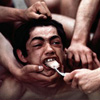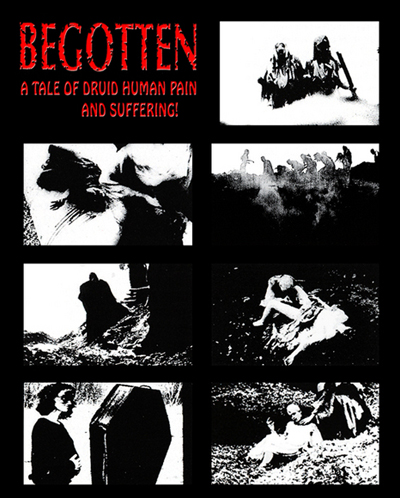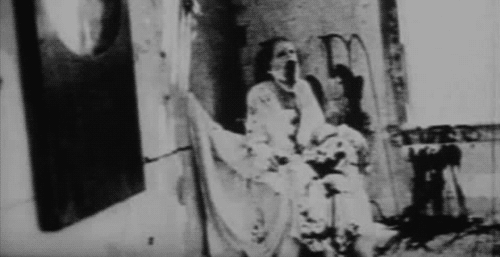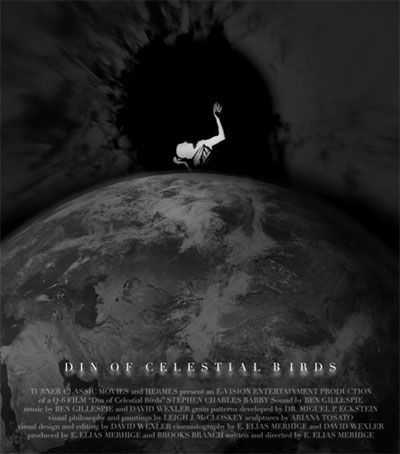Begotten: Once Seen Never Forgotten
If you search the Weird Wide Web for the most disturbing, disgusting or shocking films ever made, Begotten will very likely be on many of the lists compiled by cult film fans. Since it was first released in 1990, the controversy surrounding Begotten has never abated. Not surprising with its opening scene of God committing suicide by gutting himself with a razor. What follows is an unrelenting and unapologetic 72 minutes of intense pain and suffering, as it tells the story of the death and birth of gods.
|
The experimental horror film, written, produced and directed by E. Elias Merhige split audiences on first release, and is still much debated today. Some dismiss it as pretentious arthouse cinema, that with its scenes of violence, rape, dismemberment and cannibalism is attempting to shock for shocks sake. But that's far from the case. The retelling and re-imagining of creation myths is brutal, because many of the Pagan creation stories are themselves brutal allegories. It has been described as a re-imagining of Genesis, and there are also obvious comparisons to the story of Christ. All of that is layered in there, as the Christian myths themselves have become a sanitized retelling of those Pagan myths stretching back to the dawn of humanity. The film very much plays with symbolic religious archetypes.
Anyway, moving on from getting into the deeper theological symbolism of it, the film is something that should be experienced rather than thought too deeply about. Merhige has stated that it was inspired by a near-death experience that he had after a car crash, when he was 19. He wrote the script when he was 20, at a time when he was involved in experimental theatre, influenced by both Greek drama and the works of philosopher Friedrich Nietzsche. Originally envisioned as a theatre production, the huge costs of staging it lead Merhige to rethink Begotten as a piece of film. The film took a gruelling three and a half years to complete. |
The main reason for it taking such a long time, is due to the post production techniques that Merhige employed to create the haunting and creepy silent movie style aesthetic of the film. He spent a long time experimenting with exposure times of film stock. Not finding the look he was after, he heard about optical printers that could produce the effects he required, but one would have cost him a fortune to hire or buy. So he built one himself, over a period of 8 months. Begotten was filmed in 16mm on a reversal film stock, with each frame of original footage being rephotographed, given a high-contrast treatment and painstakingly reprinted. All to create the captivating and grotesque look of the film, which is the key to what makes it such a stand out piece of cinematic art. And probably the reason for its lasting appeal.
|
The film was shot as a silent piece, and has no dialogue. The soundtrack is nerve jangling mix of various looped sound effects, that create a hypnotic rhythm to the pulsating and flickering images on the screen. Merhige claims he wanted to induce an alter state of conciousness in viewers.
|
On release, Merhige was unsure of how audiences would view his film. He was what he called "protective of it". His break came when political activist, writer, and film-maker Susan Sontag saw the film and asked him to give a private screening at her home to a group of her close friends.
|
With its release on DVD, the film quickly developed an underground following among lovers of cult and arthouse film. Eventually leading to Merhige being commissioned to produce music videos for Marilyn Manson, and to direct the fictionalised story of the making of the classic vampire silent film Nosferatu, Shadow of the Vampire in 2000.
|
Its thought that Begotten was intended to be part of a trilogy of films. In 2006 Merhige released Din of Celestial Birds, which is considered an unofficial part 2 of that trilogy. It was written, directed and produced by Merhige, but with the cooperation of Q6 Productions, a collective of artists and philosophers. The 14 minute short begins with the phrase "hello and welcome ... do not be afraid ... be comforted ... remember ... our origin..." and proceeds to depict the first violent formation of matter from nothingness. Then starting with a single point of light, the screen explodes, and viewers are taken on an accelerated trip through the creation of the universe, the Earth, the evolution of life and ultimately human consciousness. Now that's one hell of a trip in only 14 minutes, especially considering around 4 of those minutes make up the title sequences that book-end the film.
Din of the Celestial Birds is a very different film to Begotten, despite having Merhige's cinematic style stamped all over it. Where every frame of Begotten jars you, this one is an atmospheric journey that you let wash over you. The film and the soundtrack is an almost soothing ebb and flow, rather the pulsating intensity of the former film. Merhige has stated that part of the inspiration for the styling of the film was early silent cinema. From the Lumiere brothers and Fritz Lang, to works of Jean Cocteau. |
We can only wait with anticipation as to what we will be presented with, when he eventually makes the "unofficial" 3rd part of the trilogy.

Hype & Hysteria: The Gory Story Of Video Nasties - Early 80s UK, as home video machine became popular, there was moral outcry at the horror titles that were hitting the shelves.
|

Why Modern Extreme Cinema Has Nothing On European Arthouse - The most disturbing films ever made aren't from the new wave of Extreme Cinema, but old from European arthouse.
|




